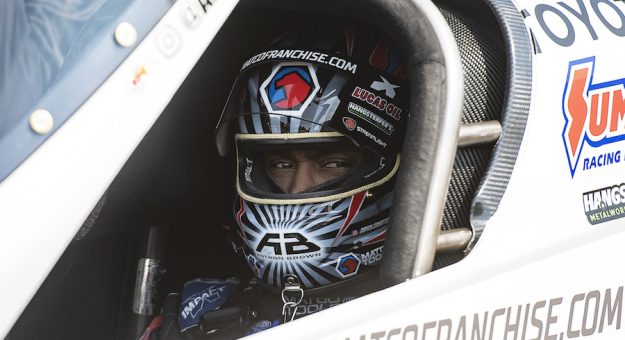When Tony Stewart made his Top Alcohol drag racing debut last October, part of the reason he elected to hit the drag strip and not an oval was his age.
“I’m too old to race in IndyCar, I’m retired from NASCAR, sprint car racing’s getting tougher and tougher — it’s a young man’s game — but drag racing, the reaction times and the aspects of it that are way different than anything else I’ve done is what’s drawing me to it,” Stewart said.
During the press conference leading up to the NHRA Nevada Nationals, the 51-year-old indicated he could envision drag racing as a career path for the next 15 to 20 years.
He wouldn’t be alone as an over-50-year-old competitor, either.
NHRA icon John Force continues to be a threat in the Funny Car class at 73 years old. Ron Capps collected his third Funny Car championship last year at age 57. And Greg Anderson was 61 years old when he earned his 100th Pro Stock win at the Dodge Power Brokers NHRA U.S. Nationals in September.
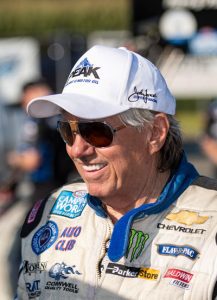
The list goes on.
Therein lies the question of what contributes to the longevity of a career in NHRA drag racing.
For 47-year-old Antron Brown, it’s about heart. Brown is the same age as NASCAR Cup Series driver Kevin Harvick, who plans to retire at the end of the season.
“Drag racing just depends on what’s inside you,” Brown said. “Dirt bike racing is the football career. NASCAR is like the basketball career. And NHRA drag racing is like baseball.”
In a sport that chiefly relies on reaction times, while the body mechanics still have to be sharp, the physical demand is considerably lower than other forms of racing.
If a driver can escape major accidents and continue to foster a love for strapping into the car, a livelihood in drag racing can last for decades.
“Am I going to be racing till I’m like John Force? No,” Brown said, shaking his head. “I know I’d like to do it for at least another 15 years, maybe until retirement age.”
That potentially puts Brown at about 65 years old when he steps out of a Top Fuel dragster for good.
On the other end of the spectrum, AMA Supercross athletes often retire at half that age.
The oldest Supercross rider to earn a 450cc class victory was Justin Brayton when he won at Daytona Int’l Speedway on March 10, 2018. He was four days away from his 34th birthday.
“I feel like Brayton had some of his best years later in his life, so it’s cool to see that and know that you can go that long,” said Chase Sexton, current rider for Honda HRC. “I would definitely like to race until my early 30s at least.”
The oldest athlete to compete in a Supercross main event is Chad Reed — who retired from the sport in 2020 at 38 years old — while the majority of Supercross stars have made their exit around 33 years old.
To put it in perspective, by age 30, most riders have been seriously competitive on a dirt bike for 20-plus years. It’s the same story for 29-year-old Jason Anderson, who has been racing since he was 7.
“For us, when we get to the end of our careers, I think it’s more mentally that we’re struggling — handling the number of races, the amount of travel, while we’re trying to do different things in our life — because we’ve been doing this since we were so young,” said the 2018 Supercross champion, who rides for Monster Energy Kawasaki.
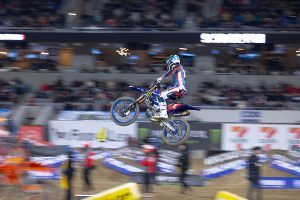
Meanwhile, at 23, Sexton is one of the younger riders in the premier class.
His main rivals are in their late 20s, in addition to 30-year-old Eli Tomac, who became the oldest Supercross champion in history when he earned his second title in 2022.
Sexton believes the key to a long career in motocross lies in managing the mental strain, keeping injuries at bay and recovering from the bodily wear and tear that inevitably comes with such a physically challenging sport.
Beyond that, he says the cards will simply fall where they may.
“I’m looking forward to each and every championship like it’s my last and I think that’s the best way to go about it,” Sexton concluded.
Team Penske’s Joey Logano certainly had no reason to view his 2022 NASCAR Cup Series championship as his last, though he was a seasoned 32 years old when he secured his second title at Phoenix Raceway in November.
While the average age of full-time Cup Series drivers has steadily decreased since 2015 — last year, the average was 30.7 years old — that statistic doesn’t necessarily reflect the age at which a driver stops being competitive.
For instance, 37-year-old Kyle Busch, 42-year-old Denny Hamlin, 44-year-old Kurt Busch and Harvick (the oldest full-time driver in the NASCAR Cup Series) all collected wins last season. At that rate, Logano essentially has 15 years before he should worry about his ability to contend for wins against the division’s young guns.
But in the modern era of NASCAR, there is more to a career than a need for speed and the physical ability to maneuver a race car and push it to its limits for hours on end.
“The drivers are making enough money now that they can achieve their wealth and their security by the time they’re 40, if they’ve been productive at all,” said Jack Roush, founder of RFK Racing. “The drivers eventually decide that they enjoy using their money to their satisfaction with their family more than they did in the past when they were still looking at every race to make the next house payment.”
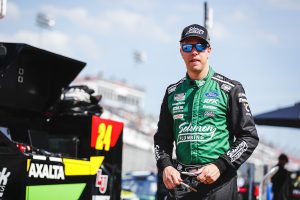
Increased sponsorship money, race winnings and external requirements that often keep drivers from their families have combined to provide a stronger case for early retirement these days.
Take Harvick for example. The 22-year series veteran recently announced he will retire at the end of the season, stating he is ready for his role as a dad and a husband to take precedence over being a driver.
Being a full-time Cup Series contender isn’t exactly a job that offers ample free time, from media requirements and sponsorships appearances to the demands of a 38-race schedule, stepping away from the sport appears to be the right call for a man with Harvick’s priorities.
But for others in the NASCAR Cup Series, such as RFK Racing co-owner and full-time driver Brad Keselowski, it’s the hunger for the next victory that keeps him in the game.
“I’ve got a lot more years of racing left,” said 39-year-old Keselowski. “I can tell you, no race car driver has any interest in getting out of a race car when they can win and compete for championships.”
As for what Stewart called a “young man’s game” — sprint car racing — the diverse array of ages found at a dirt track can be quite astounding.
Up-and-coming driver Ryan Timms was barely 16 when he made his World of Outlaws sprint car debut last year, while 57-year-old Lance Dewease was the oldest winner in the series during 2022. A majority of the remaining competitors fall in the late-20s to late-30s age range.
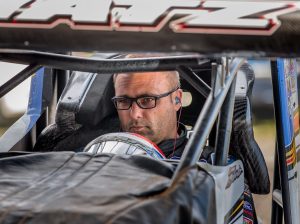
Ten-time series champion Donny Schatz, who won his first championship at age 29, was the oldest full-time World of Outlaws driver last season at age 45.
In the end, what Brown said about drag racing can arguably be true in every sport. At one point or another, the decision to retire may depend on the amount of fight that’s left in the athlete.
Like stick-and-ball sports, career longevity in motorsports can easily be dependent on injury and luck.
But unlike stick-and-ball sports, there’s nothing quite like the risks taken while thundering down a drag strip at 330 mph, flying 70 feet in the air to clear a Supercross triple jump or going wheel to wheel with 30 other cars at 200 mph for four hours.
Perhaps it’s the wisdom that comes with age that eventually leads to hanging up the fire suit or retiring the dirt bike boots, realizing there is more to life than being the first to the checkered flag.
But for drivers like Keselowski or drag racers like Force, the allure of victory and the thrill of it all may just be what keeps them the most alive.
This story appeared in the Feb. 15, 2023 edition of the SPEED SPORT Insider.
